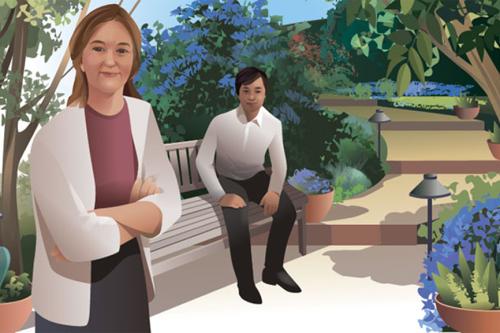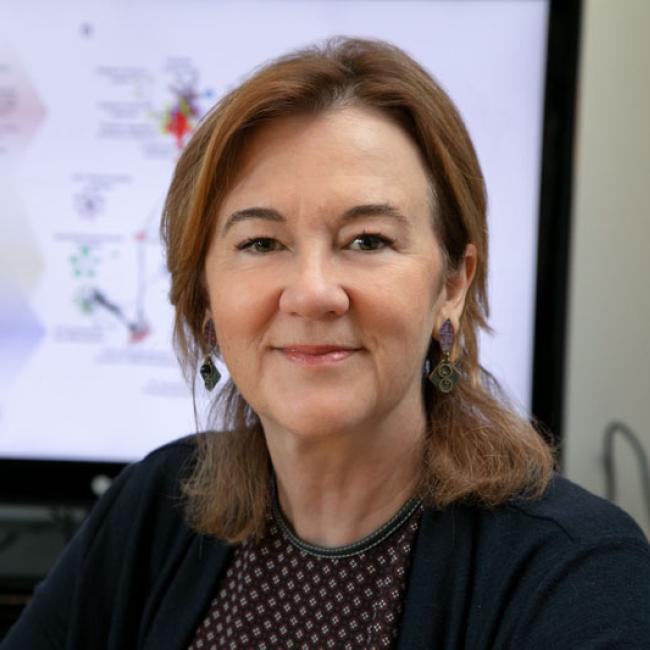
From U Magazine: Vaccine hunter
In normal times, developmental immunologist Dr. Gay Crooks's research focuses on how human hematopoietic stem cells can be isolated and manipulated to boost the body’s immune response to attack cancer cells. Now, she and colleagues in her laboratory are redirecting their expertise to studying which parts of the COVID-19 virus might trigger the strongest T-cell response and be most useful in developing an effective vaccine.
When did you start to think about science?
I loved science in elementary school, but I actually came to it, in terms of my laboratory research career, late in the game. I trained in Australia as an MD and then came to the United States for a fellowship in pediatric hematology/oncology primarily because there was a research component. Research is missing from medical training in most other countries, so I had very little exposure to it during my MD. And I found that I loved it! I thought I would come to the U.S. for a couple of years and then go back to Australia to be a physician, but I found that generating data in the lab was intoxicating.
What has been the greatest challenge in your current work?
The shutdown of research during the pandemic, without a doubt. Initially, it was an almost complete shutdown, and only a small number of people could come to the lab, just for essential reasons. Research is starting to ramp back up, but there is a limit on how many can be in the lab at any time. And the physical-distancing requirements essentially make it impossible to train anyone new. It is ironic that the nature of the pandemic has made finding a solution to it more difficult.
When you’re not in the lab working to facilitate development of a vaccine against COVID-19, where are you happiest?
In my garden. A few years ago, we converted our garden into all drought-tolerant plants and really put a lot of effort into the process. It is full of mostly native California plants — and also some Australian plants — and natural wildlife and monarch butterflies and dragonflies and lizards, and it’s a joy to spend time there.
Who's been your most important collaborator in the work to facilitate a COVID-19 vaccine?
Dr. Christopher Seet (PhD ’18, FEL ’14). His work while he was a PhD student in my lab is foundational to the approach we are taking to help to create a vaccine. During his PhD training in UCLA’s STAR program, Chris developed a method to produce a large number of dendritic cells from stem cells. Most important, he found how to make a specific type of dendritic cell that is particularly good at chopping up proteins and then presenting the pieces to the immune system to provoke a T-cell response. Much of what we’ve learned from our research in cancer immunotherapy also applies to immune responses against viruses. In this current work, we are taking blood stem cells from healthy donors and inserting certain genes from the COVID-19 virus SARS-CoV-2 into the stem cells. The stem cells are differentiated into dendritic cells, which then express the viral antigens and act as a factory to produce immune responses from T cells. Chris is using these specialized dendritic cells to try to find the key viral proteins that create an immune response and could be used as a vaccine.
Where does your inspiration come from?
From beautiful data. That’s the thing that really excites me. It can be a very simple experiment — it doesn’t necessarily have to be curing cancer — but if it’s a beautifully done experiment that reveals something unexpected but credible, there’s no feeling like it. I would think that if you are an artist and create something that is entirely new and original, it might feel similar. It is wonderful if the result matches your hypothesis, but it is even more interesting if it reveals something that you hadn’t thought about.
How are you looking at the problem of developing a COVID-19 vaccine differently from other researchers?
It’s really through our use of this specific type of dendritic cell. We all have these dendritic cells in our lymph nodes; they are normally produced from stem cells and then travel to lymph nodes, where they wait for the next virus or other foreign proteins to stimulate an immune response. But because they are so rare in the blood, it hasn’t been possible to get enough dendritic cells to work with in the lab. With our approach, we are modeling the normal developmental processes to produce large numbers of dendritic cells from stem cells, creating a great way to find the T cells that respond to the virus proteins.
What are the qualities of a great scientist?
A balance between enthusiasm/creativity and diligence. It’s like the immune system: You’ve got to be able to detect the rare event and respond to it and build on it, but you also have to temper that response by careful attention to detail to make sure that you’re not being misled. And, you have to love what you do. You can’t do good science without really loving the process.
What is your chief characteristic that makes you particularly well-suited for the research in which you now are engaged?
I think it’s my willingness to be flexible. I am looking for things that are not expected. I like detective stories and puzzles and working things out when there’s something that doesn’t quite match your expectations. And Chris is particularly well-suited for this moment because of his brilliance combined with his incredible work ethic.
What is the best moment in your day?
When a student brings in beautiful data with a smile on his or her face, and I can tell that they can’t wait to show the results to me.
How do you want to change the world?
I’d love to have a real impact on treating cancer. It would be great if we moved vaccine development through our dendritic cell work. But, ultimately, I think the way to have the biggest impact in science is through the people you train who will carry that work forward or, perhaps, go in their own new directions to achieve great things.
What is your definition of happiness?
A sense of hope built on a solid foundation — a feeling that I am on sure footing, that things are in place and secure, and I have some control over the things that matter in my life, but also that I am moving forward toward something that’s exciting and new.
What is your idea of misery?
When one cannot improve one’s situation, with no control of one’s direction and no hope for change.
What music do you listen to?
From Radiohead to Nina Simone to Brahms. It’s all good.
